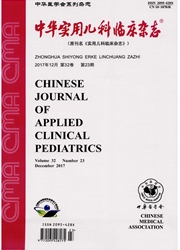

 中文摘要:
中文摘要:
目的评价多重致敏因素的支气管哮喘(哮喘)和变应性鼻炎患儿血清变应原特异性IgE(sIgE)阳性检出率的分布特征,为指导变应原回避和病情评估提供参考。方法选取128例经变应原初筛检测有2种及2种以上变应原阳性的哮喘和变应性鼻炎患儿。其中男93例,女35例;年龄1.5~16.1岁,平均7岁8个月。临床诊断哮喘并变应性鼻炎87例、变应性鼻炎38例、哮喘3例。应用UniCAP250变应原定量IgE检测系统测定29种吸入性变应原和食物变应原sIgE水平。结果各吸入性变应原阳性检出率为屋尘螨67%、户尘螨61%、粉尘螨59%、链格孢50%、热带无爪螨42%、猫上皮和毛屑29%、狗毛屑23%、蟑螂11%、北艾32%、蓰草29%、美国自蜡28%、豚草26%、柳树24%、刺柏24%、英国梧桐树24%、蓰草24%、藜22%、疣皮桦20%;各食物变应原阳性检出率为牛奶25%、鸡蛋白25%、虾7%、蟹6%、蛋黄6%、鸡肉4%、鱼2%、小麦31%、花生20%、大豆17%、桃27%、西红柿21%。检出食物致敏阳性及阴性患儿分别为65例和63例,食物致敏阳性组患儿狗毛屑、链格孢、疣皮桦、刺柏、英国梧桐树、柳树、美国白蜡、豚草、北艾、藜、狂草的阳性检出率分别为35.4%、60.0%、39.7%、41.5%、43.1%、43.1%、46.2%、43.1%、55.4%、40.0%、44.6%,均高于食物致敏阴性组患儿的阳性检出率(11.1%、39.7%、1.6%、6.3%、4.8%、4.8%、9.5%、7.9%、7.9%、3.2%、3.2%。P均〈0.05),食物致敏阳性组患儿户尘螨、粉尘螨、屋尘的阳性检出率分别为52.3%、49.2%、58.5%,均低于食物致敏阴性组患儿的阳性检出率(69.8%、69.8%、76.2%,P均〈0.05)。82.8%的哮喘并变应性鼻炎患儿和73.7%的变应性鼻炎患儿存在3种及3种以上吸人性变应原致敏。?
 英文摘要:
英文摘要:
Objective To evaluate the distribution characteristics of the positive ratio of serum allergen specific IgE(slgE) in asthmatic and allergic rhinitis children with multiple sensitization factors ,which may be beneficial for recommendations on the avoidance of allergen and assessment of atopic disease. Methods A total of 128 children with asthma and allergic rhinitis were enrolled (93 male,35 female, aged from 1.5 to 16.1 years old, and the average age was 7 years and 8 months). All of the patients were presented as positive allergic screening test results for 2 or more kinds of allergen when evaluated. Eighty-seven patients were diagnosed as asthma combined with allergic rhinitis, while 38 cases with allergic rhinitis and 3 cases with asthma. The serum sIgE levels to 29 kinds of inhalant allergens and food allergens for each patients were detected by the UniCAP250 quantified IgE measurement system. Results The positive ratios of each inhalant allergen for all the patients were as follows :67% for House dust ,61% for Dermatophagoides pteronyssinus,59% for Dermatophagoides farinae,50% for Ahernaria alternata,42% for Blomia tropicalis,29% for Cat dander,23% for Dog dander, l 1% for Cockroach ,32% for Artemisia vulgaris ,29% for Humulus scandens ,28% for White ash,26% for Ambrosia elatior,24% for Willow,24% for Mountain juniper,24% for London plane,24% for Humulus scandens,22% for Chenopodium album and 20% for Common silver birch; the positive ratios of each food allergen were as follows:25% for Milk,25% for Egg white,7% for Shrimp,6% for Crab,6% for Egg yolk,4% for Chicken,2% for Fish,31% for Wheat,20% for Peanut,17% for Soybean,27% for Peach and 21% for Tomato. Sixty-five patients with positive results to food allergens were divided into food allergen sensitization group while the other 53 patients for food allergen non-sensitization group. The positive ratios of different inhalant allergens such as Dog dander, Alternaria alternate, Common silver birch, Mountain juniper, London plane, Willow, White ash,
 同期刊论文项目
同期刊论文项目
 同项目期刊论文
同项目期刊论文
 期刊信息
期刊信息
